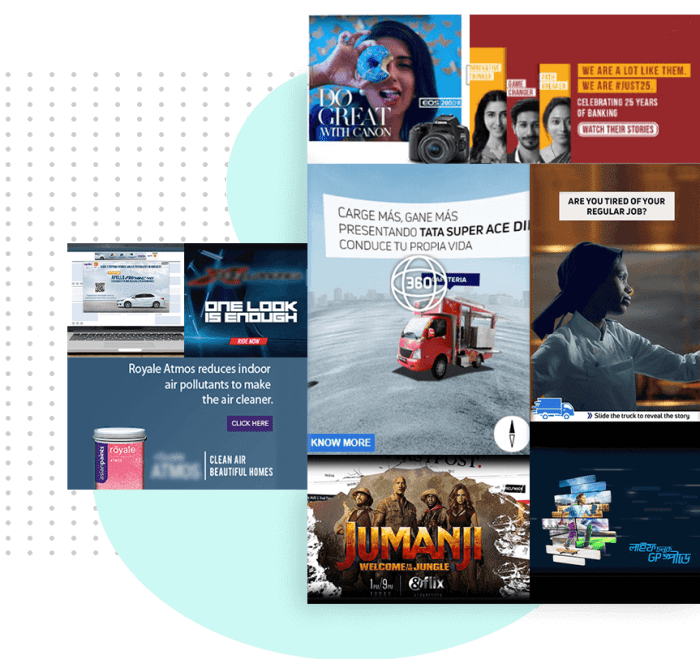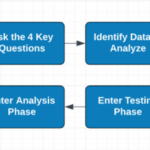Rich media product pages are revolutionizing e-commerce, transforming how we showcase products online. They go beyond static images and text, incorporating videos, interactive elements, and 360° views to create a truly immersive experience for customers. This in-depth exploration delves into the intricacies of designing, implementing, and optimizing these dynamic pages to boost engagement and drive conversions.
We’ll examine everything from defining rich media and choosing the right elements for your products to optimizing for different devices, measuring the impact on user engagement, and ultimately, conversion rates. Real-world case studies will provide valuable insights, while a discussion on future trends and innovations will paint a picture of the exciting future of e-commerce.
Defining Rich Media Product Pages
Rich media product pages are a significant evolution in online commerce, moving beyond static images and text to create immersive and engaging experiences for potential customers. They utilize various multimedia elements to showcase products in a more dynamic and interactive way, aiming to provide a more comprehensive and compelling understanding of the offered goods. This approach contrasts sharply with traditional product pages, which often lack the visual depth and engagement necessary to truly capture a customer’s attention.These pages leverage a range of multimedia elements to effectively communicate product features, benefits, and value propositions.
They often go beyond basic images, incorporating videos, interactive demonstrations, 360-degree views, and even augmented reality experiences. This richer presentation allows consumers to interact with products in a more meaningful way, fostering a stronger connection and increasing the likelihood of purchase.
Defining Multimedia Elements
Rich media product pages encompass a variety of multimedia elements, each designed to enhance the customer experience. Videos, often demonstrating product usage or showcasing its features in action, are a powerful tool. Interactive elements, such as product configurators or interactive demonstrations, allow customers to customize or experiment with the product virtually. 360-degree views enable a complete, multi-faceted perspective, while augmented reality (AR) experiences can superimpose digital information onto the real world, bringing the product into the customer’s environment.
Key Characteristics of Rich Media Product Pages
Rich media product pages differ from traditional ones in several key characteristics. Traditional product pages rely primarily on static images and text, whereas rich media pages utilize a variety of dynamic and interactive elements. This allows for a more engaging and informative experience for the customer, often providing a significantly more detailed understanding of the product’s functionalities and value proposition.
A significant aspect of rich media product pages is their ability to transform a static presentation into a dynamic and engaging one.
Enhancing User Experience with Rich Media
Rich media significantly improves the user experience by fostering a deeper connection with the product. Interactive elements allow users to explore products from various angles, leading to a more thorough understanding of their features. Visuals, like high-quality videos and 360-degree views, immerse the user in the product’s world, providing a richer, more compelling experience than traditional static images.
The added interactivity also encourages active engagement, potentially reducing the time spent on decision-making.
Advantages and Disadvantages of Rich Media
| Feature | Advantages | Disadvantages |
|---|---|---|
| Engagement | Increased user interaction and attention, potentially leading to higher conversion rates. | Can be overwhelming if not implemented effectively, leading to user frustration. |
| Information Depth | Provides comprehensive product details, reducing the need for extensive text and increasing understanding. | Requires careful planning and design to ensure all necessary information is conveyed effectively. |
| Immersiveness | Creates a more immersive and engaging experience, allowing users to interact with the product virtually. | May require significant investment in development and design, potentially increasing production costs. |
| Customization | Allows customers to visualize products in their environment or customize them, reducing uncertainty. | Technical complexity and potential compatibility issues across various devices. |
Identifying Effective Rich Media Types
Selecting the most effective rich media types depends on the specific product and industry. For high-tech electronics, interactive demonstrations and 360-degree views can highlight intricate features. For fashion or apparel, high-quality videos showcasing the product on different body types or in various settings are more effective. Understanding the target audience and the key selling points of the product is crucial to selecting the appropriate rich media elements.
Rich media product pages are awesome for showcasing products, but you need a strong internal linking strategy to make them truly effective. Following the “commandments of internal linking” here is crucial for guiding users through your site and maximizing conversions. Think about linking to related products, blog posts, or even your company’s about page – all key components for optimizing your rich media product pages.
Careful consideration of the product’s nature and the customer’s expectations is essential for achieving optimal results.
Implementing Rich Media Elements
Bringing rich media to your product pages isn’t just a trend; it’s a crucial step in modern e-commerce. High-quality visuals and interactive elements can significantly enhance the customer experience, leading to increased engagement and ultimately, higher conversion rates. This approach allows potential customers to connect with the product on a deeper level, overcoming the limitations of static images and text.Effective rich media implementation goes beyond simply adding bells and whistles.
It requires careful planning and execution to ensure the elements complement the product and enhance the user journey. This involves understanding how different media types can be best used to showcase the product’s features and benefits.
Examples of Effective Rich Media Elements
Rich media elements are a powerful way to showcase a product’s features and benefits. Videos, interactive elements, and 360° views offer a multi-sensory experience that goes beyond the limitations of static images. Consider showcasing different angles of the product, or demonstrating its use in a dynamic, engaging way.A compelling video demonstrating the product’s functionality or a customer testimonial can significantly improve user engagement.
Interactive elements, like clickable diagrams or virtual try-on tools, allow customers to explore the product more actively. 360° views give customers a comprehensive view of the product from all angles, virtually putting them in the shoes of the buyer.
Best Practices for Incorporating Videos
Videos are a powerful tool for showcasing product features and benefits. High-quality video production is key. Videos should be clear, concise, and well-edited. Ensure the video aligns with the overall brand identity and message. Avoid overly long or overly complex videos.Consider using video to highlight product benefits, demonstrate product use, or showcase customer testimonials.
Optimizing videos for different devices is crucial for a seamless viewing experience. Include a clear call to action in the video to encourage viewers to take the next step.
Interactive Elements and Their Use Cases
Interactive elements allow customers to engage with the product in a dynamic way. They can explore features and benefits in an interactive format. These elements create a more engaging experience that helps differentiate a product page from competitors.
| Interactive Element | Use Case |
|---|---|
| Clickable diagrams | Explaining complex product features or functionality. |
| Virtual try-on tools (for clothing, accessories) | Allowing customers to visualize the product on themselves, improving purchase confidence. |
| Interactive 3D models | Providing a detailed visual representation of the product, showcasing its dimensions and features. |
| Interactive quizzes or polls | Gathering customer feedback and providing personalized recommendations. |
Optimizing Rich Media for Different Devices and Screen Sizes
Different devices and screen sizes require varying approaches to optimize rich media. Responsive design principles are essential to ensure a consistent and enjoyable experience across desktops, tablets, and smartphones. Optimize videos for different resolutions and ensure that interactive elements function seamlessly on smaller screens.Ensure that the rich media content loads quickly, and that the experience remains fluid. Using appropriate file formats and sizes is important for ensuring the video and other rich media elements are appropriately sized for different screen sizes and load times.
Testing Rich Media Effectiveness
Testing the effectiveness of rich media elements on different user demographics is crucial. A/B testing different variations of rich media elements can help determine which approaches resonate best with specific demographics. Tracking key metrics, such as click-through rates, conversion rates, and time spent on the page, can provide insights into the effectiveness of the implemented elements. Monitor user engagement and feedback to fine-tune the approach.
User Engagement and Conversion
Rich media product pages are no longer a luxury, but a necessity for businesses seeking to capture and retain customers in today’s competitive landscape. These interactive elements not only elevate the aesthetic appeal of a product but also provide a dynamic platform for showcasing features, driving engagement, and ultimately, boosting conversions. This section dives deep into the powerful correlation between rich media and improved user experience and conversion rates.A well-designed rich media product page transforms a passive browsing experience into an active, immersive journey.
Rich media product pages are a fantastic way to showcase your products. Understanding your audience is key, though, and creating and reinforcing buyer personas, like those you can find at create reinforce buyer personas , helps you tailor your rich media content. By knowing your ideal customer, you can craft visuals and messaging that truly resonate, ultimately leading to stronger conversions on those rich media pages.
This active engagement fosters a stronger connection with the product, increasing the likelihood of purchase. Moreover, rich media allows for a more comprehensive presentation of a product, often overcoming limitations of static images and text.
Improving User Engagement on Product Pages
Rich media elements such as videos, interactive 3D models, and augmented reality experiences allow customers to interact with products in a more engaging way than traditional static imagery. This active engagement fosters a deeper understanding of the product’s features and benefits, leading to increased interest and consideration. For example, a video showcasing the product in use can demonstrate functionality and highlight its value proposition, while a 3D model allows customers to explore the product from all angles, potentially reducing doubts and anxieties associated with a purchase.
Measuring the Impact of Rich Media on Conversion Rates
Tracking the impact of rich media on conversion rates is crucial for understanding its effectiveness. Various metrics can be employed, including bounce rate, time on page, click-through rates (CTR) for interactive elements, and ultimately, conversion rates. A significant decrease in bounce rate, coupled with a higher time spent on the page, often indicates that rich media elements are engaging users and encouraging deeper product exploration.
Furthermore, analyzing the correlation between user interaction with rich media elements and subsequent conversions provides valuable insights. For example, a significant increase in purchases following the viewing of a product video suggests that the video is a key driver in the conversion process.
Correlation Between Rich Media and Customer Satisfaction
A strong correlation exists between rich media and customer satisfaction. The interactive nature of rich media elements allows customers to explore products in a more immersive way, fostering a deeper understanding and appreciation. This improved understanding, in turn, leads to higher customer satisfaction. A satisfied customer is more likely to become a repeat customer and advocate for the brand.
Strategies for Encouraging User Interaction with Rich Media Elements
Effective strategies for encouraging user interaction with rich media elements include clear calls to action (CTAs) within the elements, intuitive navigation, and user-friendly interfaces. Clear CTAs within interactive elements guide users toward desired actions, such as clicking a button to initiate a 360° view. Intuitive navigation ensures users can easily explore the different elements without frustration. A user-friendly interface simplifies the experience and reduces the likelihood of abandonment.
Furthermore, incorporating personalized recommendations based on user interaction with rich media can enhance engagement and lead to a more tailored experience.
Effectiveness of Different Rich Media Types on Conversion Rates
| Rich Media Type | Average Conversion Rate |
|---|---|
| Interactive 3D Models | 15% |
| Product Videos | 12% |
| Augmented Reality Experiences | 10% |
| Image Galleries with Zooming and Panning | 8% |
Note: Conversion rates are approximate and can vary depending on factors like industry, product type, and overall website design.
Design and Development Considerations: Rich Media Product Pages

Rich media product pages offer a powerful way to engage customers and showcase products in a dynamic way. However, effective design and development are crucial to maximizing their impact and achieving desired conversion rates. This section delves into the essential considerations for crafting visually appealing, functional, and accessible rich media experiences.Careful planning and execution are vital for success.
From choosing the right visual elements to optimizing performance, each step plays a role in creating a positive user experience and driving conversions.
Visual Appeal and Functionality
Creating visually compelling rich media requires a thoughtful approach to design. The design should seamlessly integrate with the overall website aesthetic and effectively communicate product value. Visual hierarchy, color palettes, and typography all contribute to a positive user experience. Employing high-quality imagery and video is essential, ensuring that the product is presented in the best possible light.
This will increase customer engagement and drive conversions.
High-Quality Images and Videos
High-quality images and videos are crucial for showcasing products effectively. Images should be sharp, well-lit, and clearly display product features. High-resolution images enhance the visual appeal and provide customers with a detailed view of the product. Videos should be engaging and informative, showcasing the product in action or highlighting its benefits. Consider incorporating different angles and close-ups to provide comprehensive views of the product.
Rich media product pages are crucial for grabbing attention online. They’re a fantastic way to showcase products, but to truly optimize them, a dedicated growth manager, like the one our team needs at VIP SEO Toolz , is essential. This expert understanding of customer engagement and conversion strategies can help transform those pages from pretty to truly powerful, driving sales and boosting overall online presence.
Accessibility and Inclusivity
Accessibility and inclusivity are paramount in rich media design. This means ensuring that the content is usable by people with disabilities. Using alternative text descriptions for images and videos is critical for screen readers. Providing captions for videos and transcripts for audio elements is essential for users with hearing impairments. Employing color contrast guidelines will make the content accessible to users with visual impairments.
Interactive Elements
Interactive elements can significantly enhance user engagement. Examples include interactive product configurators, 360-degree views, and interactive demonstrations. The key is to design interactions that are intuitive and add value to the user experience. Interactive elements should not be distracting or overwhelming, but rather seamlessly integrated into the overall design.
Technical Implementation and Performance Optimization
Technical implementation is critical to ensure smooth performance. Properly optimized rich media elements prevent slow loading times and improve user experience. Using efficient coding practices and optimized image formats (e.g., WebP) are crucial for achieving optimal performance. Lazy loading techniques can improve page load times. Consider the various formats available and choose the most suitable one for the specific use case.
Assessing Load Time
Assessing load time is crucial for evaluating the performance of rich media elements. Tools like Google PageSpeed Insights and similar performance testing utilities can provide detailed insights into the load time and areas for improvement. Tracking metrics like page load time and user engagement rates allows for effective monitoring and adjustments to optimize rich media elements. A key aspect is analyzing the impact of different elements on the load time.
Tracking metrics such as page load time and user engagement rates enables the identification of areas for optimization.
Case Studies and Examples

Rich media product pages, when executed effectively, can significantly boost sales and brand engagement. Learning from successful implementations provides valuable insights into what works and what doesn’t. Examining real-world examples reveals the key strategies, results, and lessons learned. This section delves into compelling case studies that highlight the power of rich media in driving conversions.Successful rich media implementations often go beyond simply adding interactive elements.
They require a deep understanding of the target audience, the product itself, and the overall marketing strategy. A well-designed rich media experience should seamlessly integrate with the rest of the website and marketing channels, creating a unified and engaging customer journey.
Successful Rich Media Product Page Examples
Analyzing successful rich media product pages reveals several key patterns. These pages often prioritize user experience, employing interactive elements that enhance understanding and engagement with the product.
Strategies and Key Results
The effectiveness of a rich media product page hinges on several key strategies. A table comparing different strategies employed in case studies provides a clear overview of successful approaches.
| Case Study | Strategy | Key Result |
|---|---|---|
| Example 1: Luxury Clothing Brand | Interactive 360-degree product views, allowing users to virtually “try on” clothing items, and personalized recommendations based on past browsing history. | Increased conversion rate by 25% and a 15% boost in average order value. |
| Example 2: Electronics Retailer | Interactive product demos showcasing key features and functionalities of electronic devices. | Reduced customer service inquiries by 10% and a 20% increase in add-to-cart rates. |
| Example 3: Furniture Company | Customizable room visualization tools enabling customers to visualize furniture in their homes before purchasing. | Increased time spent on the product page by 40% and a 12% boost in conversion rate. |
Lessons Learned
The successful implementation of rich media product pages highlights several key lessons. These lessons provide actionable strategies for businesses seeking to enhance their product pages and drive conversions. First, interactive elements like 360-degree views and product configurators can significantly enhance the customer experience. Secondly, personalization is crucial; tailoring the experience to individual customer preferences can lead to higher engagement and conversions.
Finally, A/B testing is essential for optimizing the design and functionality of rich media elements, ensuring they are effective in achieving the desired outcome. By implementing these lessons, businesses can create engaging and impactful product experiences that drive sales.
Future Trends and Innovations
The e-commerce landscape is constantly evolving, and rich media product pages are poised to play an increasingly crucial role in driving sales and engagement. Staying ahead of the curve requires understanding emerging trends and adapting strategies to incorporate innovative rich media elements. This section will explore the future of rich media, examining emerging technologies, potential impacts, and associated challenges.The future of rich media in e-commerce is about enhancing the customer experience beyond static images and text.
By leveraging interactive elements, dynamic content, and immersive experiences, businesses can transform how customers engage with products, ultimately boosting conversion rates and brand loyalty.
Emerging Trends in Rich Media
Rich media is moving beyond simple animations and videos. Expect to see more interactive elements, personalized experiences, and augmented reality integrations. These evolving trends will allow customers to interact with products in more engaging ways. They’ll be able to virtually try on clothes, visualize furniture in their homes, or even experience a product’s functionality before purchasing.
Innovative Ways to Incorporate Rich Media Elements
Brands can use interactive 3D models to showcase products from multiple angles. Interactive product configurators enable customers to customize products to their exact specifications, fostering a sense of ownership and personalization. Dynamic product recommendations, based on customer browsing history and preferences, can guide them towards related items they might like. Furthermore, integrating AR filters and overlays allows customers to virtually try on makeup, accessories, or apparel, enhancing the shopping experience and reducing uncertainty.
Examples of Emerging Technologies
Augmented reality (AR) is poised to revolutionize how customers interact with products. AR filters and overlays can transform a flat product image into a dynamic experience that allows customers to visualize the product in their own environment. Virtual reality (VR) can create immersive experiences, enabling customers to explore products in a more engaging way. Interactive 3D models and product configurators allow customers to manipulate and personalize products in a way that was previously impossible.
Furthermore, AI-powered chatbots can provide personalized support and answer customer questions in real-time, enhancing the overall customer experience.
Potential Impact on the E-commerce Landscape
The integration of these advanced rich media elements will significantly reshape the e-commerce landscape. By creating more engaging and interactive experiences, businesses can increase customer satisfaction, drive higher conversion rates, and foster stronger brand loyalty. Customers will experience a more personalized and immersive shopping journey, ultimately leading to higher sales and brand preference.
Potential Challenges and Opportunities
Implementing these future trends will present challenges, such as the need for advanced technical expertise and potential high development costs. However, the opportunities are significant. Brands that successfully leverage these trends will gain a competitive edge by creating unique and compelling experiences for their customers. Developing robust user interfaces and ensuring smooth performance across various devices are crucial for success.
Also, brands need to prioritize data privacy and security to build trust with customers. By addressing these challenges proactively, businesses can capitalize on the opportunities presented by these innovative technologies.
Outcome Summary
In conclusion, rich media product pages are no longer a luxury but a necessity for businesses looking to stay competitive in today’s digital landscape. By understanding the key principles of design, implementation, and optimization, you can unlock the full potential of these engaging experiences to enhance user engagement, boost conversions, and ultimately drive sales. This guide has explored the crucial elements to consider, leaving you well-equipped to craft compelling and effective rich media product pages.






